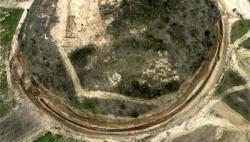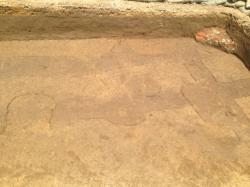INSTITUT SUPERIEUR D'ANTHROPOLOGIE
INSTITUTE OF ANTHROPOLOGY
ONLINE COURSES / COURS A DISTANCE
FALL TERM : OCTOBER 2013
REGISTER NOW
SRI LANKA - Haldummulla – Wa Eliya – Hunugalaagala cave - During recent excavations in the Haldummulla – Wa Eliya – Hunugalaagala cave, fragments of female sculptures have been discovered and parts of grinding instruments were also unearthed. Based on the artifacts unearthed Prof. Somadeva believes that this cave may have been used approximately 5000 years ago as a place of worship to bless pregnant mothers. Prof. Somadeva believes that this is a significant piece of evidence in the transition of the native people from being hunter gatherers to those who believe in the supernatural.
http://www.hirunews.lk/65679
TURQUIE –  Edirne - Ongoing archaeological excavations at Edirne Palace, one of the Ottoman palaces in the northwestern province of Edirne, have revealed meerschaum tobacco pipes, which date back to the 15th century and after. The pipes are estimated to have been used by the sultans and other top officials of the palace. The construction of the palace complex, which was the capital of the Ottoman Empire for 92 years, began in 1450 on the island between the two reaches of Tunca River at the time of Sultan Murat II. The palace was extended in the reign of Sultan Mehmet the Conqueror and took the name Sary-ı Cedid. With renovations and extensions by Kanuni Sultan Süleyman and Mehmet IV, the palace became a magnificent one with 117 rooms, 18 baths, 18 small mosques and other parts. The palace served as an armory from 19th century but Russian occupation in 1878 caused the destruction of the palace. It was set on fire on Jan. 18, 1878 with the order of Edirne Mayor Cemil Pasa in order to prevent the Russian army from seizing the armory. After the three-day fire, only a few sections of the palace survived. The head of the excavations and Bahçeşehir University member Associate Professor Mustafa Özer said that excavations had been continuing with a 70-person team, adding, “During this year’s works, objects such as ceramics, meerschaum, coins, and glass were found. Also among the findings, kitchen tools and many meerschaum tobacco pipes draw attention. We estimate that these pipes were used by top officials of the palace and sultans. They date back to the end of 15th century and 19th century. There are many findings belonging to Sultan Mehmet the Conqueror, Kanuni Sultan Süleymad and Mehme IV.”
Edirne - Ongoing archaeological excavations at Edirne Palace, one of the Ottoman palaces in the northwestern province of Edirne, have revealed meerschaum tobacco pipes, which date back to the 15th century and after. The pipes are estimated to have been used by the sultans and other top officials of the palace. The construction of the palace complex, which was the capital of the Ottoman Empire for 92 years, began in 1450 on the island between the two reaches of Tunca River at the time of Sultan Murat II. The palace was extended in the reign of Sultan Mehmet the Conqueror and took the name Sary-ı Cedid. With renovations and extensions by Kanuni Sultan Süleyman and Mehmet IV, the palace became a magnificent one with 117 rooms, 18 baths, 18 small mosques and other parts. The palace served as an armory from 19th century but Russian occupation in 1878 caused the destruction of the palace. It was set on fire on Jan. 18, 1878 with the order of Edirne Mayor Cemil Pasa in order to prevent the Russian army from seizing the armory. After the three-day fire, only a few sections of the palace survived. The head of the excavations and Bahçeşehir University member Associate Professor Mustafa Özer said that excavations had been continuing with a 70-person team, adding, “During this year’s works, objects such as ceramics, meerschaum, coins, and glass were found. Also among the findings, kitchen tools and many meerschaum tobacco pipes draw attention. We estimate that these pipes were used by top officials of the palace and sultans. They date back to the end of 15th century and 19th century. There are many findings belonging to Sultan Mehmet the Conqueror, Kanuni Sultan Süleymad and Mehme IV.”
http://www.hurriyetdailynews.com/sultans-tobacco-pipes-discovered.aspx?pageID=238&nID=53034&NewsCatID=375
GRECE –  Amphipolis - Greece's Culture Ministry has warned against "overbold" speculation that an ancient artificial mound being excavated could contain a royal Macedonian grave or even Alexander the Great. Site archaeologist Aikaterini Peristeri has voiced hopes of finding "a significant individual or individuals" within. Greek websites enthused that it could hold the long-sought grave of 4th-century B.C. warrior-king Alexander the Great — thought to lie in Egypt. A Culture Ministry statement Thursday said the partly-excavated mound has yielded a "very remarkable" marble-faced wall from the late 4th century B.C. It is an impressive 500 meters (yards) long and three meters high. But the ministry warned it would be "overbold" to link the site near ancient Amphipolis, 370 miles (600 kilometers) north of Athens, with "historic personages" before the excavation is completed.
Amphipolis - Greece's Culture Ministry has warned against "overbold" speculation that an ancient artificial mound being excavated could contain a royal Macedonian grave or even Alexander the Great. Site archaeologist Aikaterini Peristeri has voiced hopes of finding "a significant individual or individuals" within. Greek websites enthused that it could hold the long-sought grave of 4th-century B.C. warrior-king Alexander the Great — thought to lie in Egypt. A Culture Ministry statement Thursday said the partly-excavated mound has yielded a "very remarkable" marble-faced wall from the late 4th century B.C. It is an impressive 500 meters (yards) long and three meters high. But the ministry warned it would be "overbold" to link the site near ancient Amphipolis, 370 miles (600 kilometers) north of Athens, with "historic personages" before the excavation is completed.
http://www.therepublic.com/view/story/64a69efe08634ca5ad6c6b1e9886802d/EU-Greece-Archaeology-Ancient-Mound
GRECE -  Santorin - According to a new study of insect pests found in an ancient storage vessel on Santorini, the volcanic eruption which ended the Minoan civilization took place sometime between June to early July, around 1600 BC. The study titled “Ancient pests: the season of the Santorini Minoan volcanic eruption and a date from insect chitin” was published in a recent issue of Naturwissenschaften and signed by Eva Panagiotakopulu, Thomas Highham, Anaya Sarpaki, Paul Buckland and Christos Dumas. As written in the abstract of the paper: “Attributing a season and a date to the volcanic eruption of Santorini in the Aegean has become possible by using preserved remains of the bean weevil, Bruchus rufipes, pests of pulses, from the storage jars of the West House, in the Bronze Age settlement at Akrotiri. ”We have applied an improved pre-treatment methodology for dating the charred insects, and this provides a date of 1744–1538 BC. This date is within the range of others obtained from pulses from the same context and confirms the utility of chitin [protein that makes up the insects' shells] as a dating material. Based on the nature of the insect material and the life cycle of the species involved, we argue for a summer eruption, which took place after harvest, shortly after this material was transported into the West House storeroom”.
Santorin - According to a new study of insect pests found in an ancient storage vessel on Santorini, the volcanic eruption which ended the Minoan civilization took place sometime between June to early July, around 1600 BC. The study titled “Ancient pests: the season of the Santorini Minoan volcanic eruption and a date from insect chitin” was published in a recent issue of Naturwissenschaften and signed by Eva Panagiotakopulu, Thomas Highham, Anaya Sarpaki, Paul Buckland and Christos Dumas. As written in the abstract of the paper: “Attributing a season and a date to the volcanic eruption of Santorini in the Aegean has become possible by using preserved remains of the bean weevil, Bruchus rufipes, pests of pulses, from the storage jars of the West House, in the Bronze Age settlement at Akrotiri. ”We have applied an improved pre-treatment methodology for dating the charred insects, and this provides a date of 1744–1538 BC. This date is within the range of others obtained from pulses from the same context and confirms the utility of chitin [protein that makes up the insects' shells] as a dating material. Based on the nature of the insect material and the life cycle of the species involved, we argue for a summer eruption, which took place after harvest, shortly after this material was transported into the West House storeroom”.
http://www.archaiologia.gr/en/blog/2013/08/23/figuring-out-the-season-of-the-santorini-minoan-volcanic-eruption/
USA –  Jamestown - Traces of ten furrows have been discovered at the site of James Fort, built by English settlers in 1607. The furrows were found under a wall that was built in 1608 to extend the structure, so archaeologists think they were dug soon after the colonists’ arrival. Without the help of animals for farming, the labor-intensive rows were hoed by hand. “That system of farming with bending over and hoeing up the ground dominates the Virginia landscape for centuries,” said archaeologist David Givens of Jamestown Rediscovery. Soil samples will be tested to see what crops were grown in the furrows.
Jamestown - Traces of ten furrows have been discovered at the site of James Fort, built by English settlers in 1607. The furrows were found under a wall that was built in 1608 to extend the structure, so archaeologists think they were dug soon after the colonists’ arrival. Without the help of animals for farming, the labor-intensive rows were hoed by hand. “That system of farming with bending over and hoeing up the ground dominates the Virginia landscape for centuries,” said archaeologist David Givens of Jamestown Rediscovery. Soil samples will be tested to see what crops were grown in the furrows.
http://www.archaeology.org/news/1239-130822-virginia-james-fort-farming